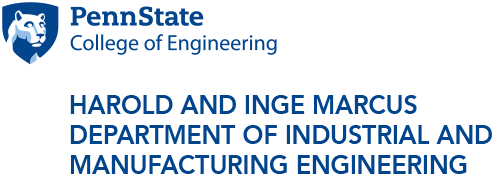
The industrial engineering team who worked on the SEE 360 project: Seniors Ellen Graszl, Kristen Donmoyer, Kelly Gagnon and Arti Patel along with Jinkun Lee, postdoctoral scholar and lecturer.
IE student project aims to help local restaurants improve service
4/20/2016
UNIVERSITY PARK, Pa. — Service engineering has been emerging as one of the fastest growing engineering industry endeavors in the United States, as total overall employment in the service sector has exceeded 80 percent.
Service engineering, or service enterprise engineering, can be defined as modifying intangible experiences — such as doctors’ or emergency room visits, experiences in mobile phone service stores or interactions with call centers — in order to streamline efficiencies while improving customer service and satisfaction.
As part of the Harold and Inge Marcus Department of Industrial and Manufacturing Engineering’s commitment to its Service Enterprise Engineering Initiative (SEE 360), a group of four industrial engineering undergraduate students — under the guidance of Jinkun Lee, a postdoctoral researcher and lecturer in the Marcus department — visited local restaurants this spring to gather data on the service rates at the establishments.
“The goal of this project was to gather real-world data from restaurants in order to show the variations that can occur in a service industry,” said Lee. “There is no perfect pattern of data in this project as is often the case in textbook examples these students see in their classes, so it was important for them to see for themselves how data can vary.”
The team was interested in collecting data from relatively small restaurants with steady arrival rates and an open floor plan so all of the tables could be visible from the location the students sat to collect data.
The students approached four restaurants and all agreed to participate on the condition that the data associated with the establishments remained confidential.
“Some of the restaurant managers were reluctant at first but once we explained our project and assured them that the data would remain anonymous, they were willing to talk to us,” said senior Kelly Gagnon, a Schreyer Scholar. “I think they were truly interested in helping us and seeing some results.”
Data was collected two or three times from each restaurant (depending on how much data the team was able to collect the first and second times). The students recorded the times at which customers arrived, were seated, ordered food, were served their food, received their bill and left the restaurant. The size of the party and the location of the table at which they were seated were also noted.
“We tried to go to each restaurant during two non-busy times and one busy time to track the service and have enough data to bring back and analyze,” said senior Kristen Donmoyer.“There were some places we literally stayed at all day so we had enough data after only two visits.”
The students were divided into two teams to gather the data in order to cover more ground. During the data gathering process, one student observed the arrival, seating and departure times for each party, as well as the table at which the diners sat. The other student noted the order, service and payment times for each table. The two sets of data were then combined based on each table in order to track each dining party’s overall experience in the establishment.
“We sat at a table with our laptops and took timestamps of every service action from when customers walked in to when they were seated, when they placed orders, when they were served, when they paid and when they left,” explained senior Ellen Grazl, a Marcus Scholar. “Sometimes it was really intense but other times, it was slow. It seemed more like people-watching than collecting data at times.”
After the data is analyzed, the students will report their findings to the restaurants.
“The restaurant managers really seemed interested in the results of this project so that maybe they can improve some of their processes,” said senior Arti Patel, a Schreyer Scholar. “The experience at every restaurant was different — some establishments encourage a lingering experience with appetizers and drinks offered, while others are more of a fast-paced atmosphere with high turnover rates so the results should be interesting.”
The data collected at one establishment in particular will be further analyzed by a simulation model, and will then be shared with the restaurant’s management team at the end of the project.
“I expect this collaboration may lead to a further study, which will increase our understanding of real service enterprise problems and find a better solution by using various industrial and manufacturing engineering optimization tools,” said Lee.
Overall, the project brought together concepts such as probabilities, statistics and simulation, that are taught in several industrial engineering courses, including I E 322: Probabilistic Models in Industrial Engineering, I E 323: Statistical Methods in Industrial Engineering, I E 453: Simulation Modeling for Decision Support and I E 460: Service Systems Engineering.
“It was important to gather this data that can then be used by faculty in industrial engineering classes as real-world examples rather than textbook case studies,” said Lee. “It isn’t as clean and perfect as the hypothetical examples they are given in class so the data can be used for many different projects in several different courses.”
Industrial engineers at Penn State have been working with a variety of service sectors, such as banking, healthcare, transportation and more, to apply their knowledge of engineering to the unique challenges these businesses face.
“Our mission for SEE 360 is to contribute to engineering education at Penn State by introducing students to the opportunities in service industries and applying engineering techniques to improve productivity in service sector,” said Charles Schneider, the founder and chairman of U.S. Security Associates, Inc., a $1.3 billion business.
A Penn State mechanical engineering alumnus, Schneider and his wife Enid gifted money to the Marcus department to establish the Fund for Excellence in Service Engineering. He is the chair of the Service Enterprise Engineering Advisory Board, which provides input on service engineering curriculum and identifies emerging research areas to the Marcus department.
“We anticipate that projects such as this will provide students authentic service industry contexts across multiple courses throughout their learning experience in engineering,” he said. “Ultimately, they will be ready to solve the unique challenges and really pioneer new ways of thinking in the service sector.”


